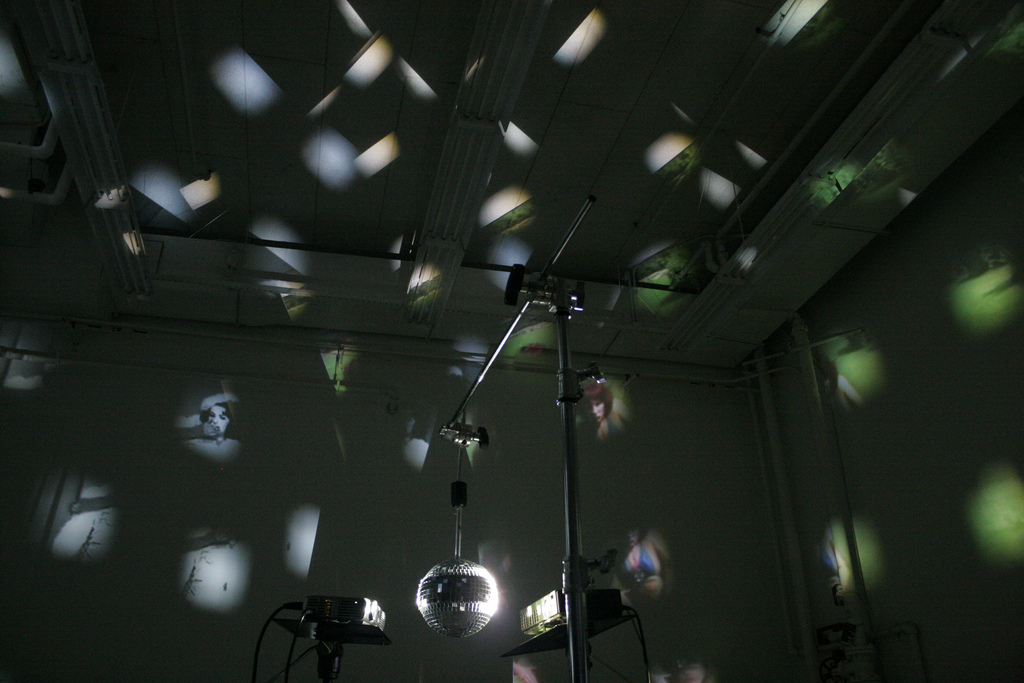Calit2 Gallery to Host 'Discotrope: The Secret Nightlife of Solar Cells'
San Diego, Calif., March 16, 2012 — Like a regular disco ball, the Discotrope is covered in mirrored facets that, when rotated, reflect light onto the walls and ceiling of a darkened room. Upon closer inspection, however, the Discotrope looks a little unusual: Along its equator, the mirrors have a different hue. That’s because some of the faces of the Discotrope aren’t mirrors at all —they’re solar cells.
|
What is the Discotrope? “It’s an unconventional, wacky, crazy projection system. It’s a solar powered disco ball,” explains Amy Alexander, audiovisual performance artist and associate professor of Visual Arts at the University of California, San Diego. Alexander has been collaborating with Syracuse University Assistant Professor of Transmedia Annina Rüst on the project since its inception nearly three years ago.
The solar cells have one purpose on the Discotrope: to power the rotation of the ball. Yet because they are photovoltaic, the cells are affected by the light that is being projected upon them. The brighter the light that Rüst and Alexander shine on the Discotrope, the more electricity is produced, and the faster the ball spins.
“Solar cells were really an interesting way of powering the Discotrope,” explains Alexander. “It ties into the performability because the light affects the movement.”
The public is invited to have a look at “Discotrope: The Secret Nightlife of Solar Cells” on Monday, March 19 at the gallery@calit2, which is located on the first floor of Atkinson Hall at the the UC San Diego division of the California Institute for Telecommunications and Information Technology (Calit2). The event will begin at 7 p.m. with a reception at the gallery, followed by the outdoor performance in the Atkinson Courtyard at 7:30. In case of rain, the performance will be moved indoors.
|
Rüst, who is also an electronic and software artist, explains that “typical research on solar cells is to improve energy production, we don’t use solar cells like other people do. As artists, we think about what else we can do with technology. We see the solar cells as giving us the possibility to create a certain different type of aesthetic.”
Rather than using simple ultraviolet light to power the Discotrope (as one would power a photovoltaic cell) the artists project video clips of people dancing onto the ball, which are then reflected off its surface and onto the walls and ceiling. .
“As for the content, it’s focused on dance, and on the idea of ‘dancing at cameras,’” Alexander explains. “In early film tradition, films were based on vaudeville and theater, where the performer is dancing at the audience. Then we moved away from that as cinematic narrative developed. Now with YouTube, we are back to dancing at the camera.”
To add one farther dimension to the performance, Rüst and Alexander have collaborated with Cristyn Magnus, a Music Ph.D. from UC San Diego who has developed an algorithmic sound design for the project.
Alexander developed software to control the brightness and therefore the speed of the individual video clips being presented. Her software then communicates with Magnus’ music software, telling it such information as which clips are being played and the speed of the corresponding soundtrack. The music algorithm then mixes sounds from the original videos in various ways.
“The original music from each video is used, but it’s a remix. For example, you’d have ‘Single Ladies’ mixed with 1940s Burlesque film soundtracks,” explains Alexander. “The software is like a musical instrument. I’m improvising by listening to Magnus’s musical instrument and performing on my visual instrument.”
“It’s an improvised performance,” emphasizes Rüst. “We have a loose script of what we do, but it follows a certain train of thought. It’s rehearsed but improvised.”
Alexander explains that the Discotrope gets its name from the Zoetrope an ancient entertainment device that produces the illusion of motion using a series of static pictures, “much like a flipbook.”
“Similarly,” says Alexander, “the viewer of the Discotrope puts together fragmented video clips into a whole room of many small coordinated moving pictures.”
The performance is entitled “The Secret Nightlife of Solar Cells” because of this alternate and unusual use of photovoltaics for artistic purposes. “The solar cells have been out all day working hard making energy. Now they want to relax, have a drink, go out dancing, have some fun,” says Alexander.
You can read more about the Discotrope, as well as watch videos of the ball in action at the team’s website, http://discotrope.org.
Media Contacts
Claire Discenza
Media Contact: Tiffany Fox, tfox@ucsd.edu, 858-246-0353


